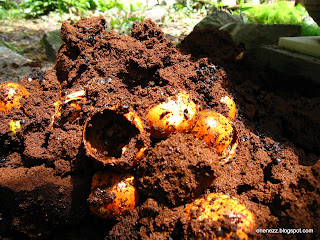So much has been said about the advantages of using coffee ground as a fertilizer. Is it all true? There seem to be a fair bit of contradictory information floating around? I decided to use them anyway.
Below are used coffee ground, tea powder and eggshells.
I spread these 3 ingredients around the base of plants and cover them with soil and mulch.
Let me just call this mixture the Coffee Ground Mixture.
I also throw some into the compost pile which seems to become very hot with it.
I have been spreading them in the garden for over a month now. Altogether, I must have saved about 40kg of unwanted stuff that normally would end up in the garbage dump and producing methane gas...
My Experience with Coffee Ground Mixture
1. Bird Nest's Fern leaves seem greener.
2. Red Japanese Rose flower abundantly.
3. Thai Jasmine too.
3. Pink Japanese Rose looks prettier.
(Of course this is just my imagination)
4. Sugar Apple begins to flower.
5. Lawn a little greener
&
6. Creeper growing from the side of the compost healthily.
(This creeper was actually one of the compost material which must have dropped to the side and then took advantage of the rich compost.)
Serious Notes to Ponder:
Is used coffee ground a miracle to the garden or a myth?
Would I say life has become a bed of (Japanese) roses after using it?
The Truth
1. Coffee ground and egg shells did not deter any snails nor slugs as claimed by many.
I had thought perhaps the big ones are strong.
But the tiny ones are still around too.
2. My darling earthworms are becoming obese which is a good thing.
(Why should we expect earthworms to love coffee ground and snails to hate it?)
3. Coffee ground didn't poison my dogs.
(They didn't even poison the slugs!!!)
4. It does perk up the plants and probably the dog too.
(Please do not intentionally feed coffee grounds to your dogs)
4. A word of Caution here. Do not allow coffee ground to touch the soft stem of plants as it will kill the plant indirectly.
The Verdict
I will continue to use this Coffee Ground Mixture as I believe it is one of the ways to Feed The Earth and reduce wastage. If the earthworms are happy, I must be doing something right.






















































